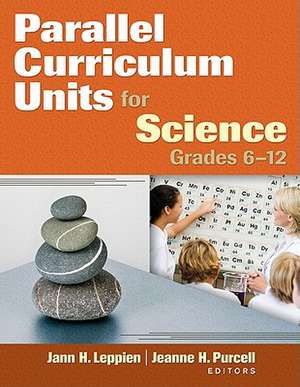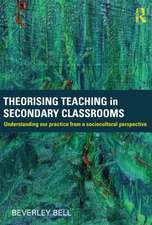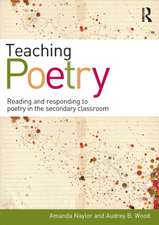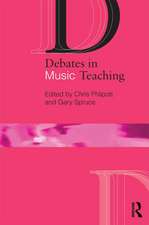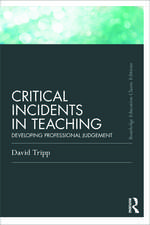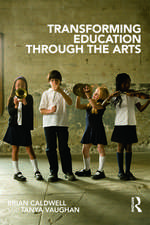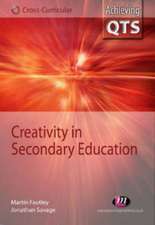Parallel Curriculum Units for Science, Grades 6-12
Editat de Jann H. Leppien, Jeanne H. Purcellen Limba Engleză Paperback – 11 apr 2011
- Exploring the nature of knowledge
- Discovering connections between science and other subjects
- Deepening science understanding according to their interests and abilities
- Connecting science learning to society through the study of genetics, historic events, literature, and chemistry.
Each unit includes subject matter background, a content framework, study components, teacher reflection activities, and sample lessons. Also available are online content tools such as handouts, PowerPoint presentations, and research activities. Breathe new life into science learning with this powerful guidebook written by master educators.
Preț: 324.83 lei
Nou
Puncte Express: 487
Preț estimativ în valută:
62.16€ • 64.77$ • 51.47£
62.16€ • 64.77$ • 51.47£
Carte tipărită la comandă
Livrare economică 03-17 aprilie
Preluare comenzi: 021 569.72.76
Specificații
ISBN-13: 9781412965422
ISBN-10: 141296542X
Pagini: 240
Dimensiuni: 216 x 279 x 14 mm
Greutate: 0.65 kg
Ediția:1
Editura: SAGE Publications
Colecția Corwin
Locul publicării:Thousand Oaks, United States
ISBN-10: 141296542X
Pagini: 240
Dimensiuni: 216 x 279 x 14 mm
Greutate: 0.65 kg
Ediția:1
Editura: SAGE Publications
Colecția Corwin
Locul publicării:Thousand Oaks, United States
Recenzii
“The parallel curriculum model provides a useful framework for creating lessons that are appropriate for all students. Applying it to science, the authors challenge students to think critically in all they do, synthesizing material within the STEM disciplines as well as reaching out to connect to the humanities. The teacher reflections offer relevant tips to maximize the effect of each aspect of the lesson. Most of all, the authors respect their students and their right to interact with challenging curriculum. I highly endorse these units for secondary students and am so excited with the challenge these units provide.”
"Dr. Leppien and her colleagues provide a user-friendly approach to motivating young people through meaningful scientific investigations. I am pleased to incorporate this text into my graduate courses in gifted education."
"Teachers at various stages of professional development in curriculum design will find these materials powerful examples that will guide their growth and development and sharpen their skills."
“President Obama stated that 'Science is more essential for our prosperity, our security, our health, our environment, and our quality of life than it has ever been' (2009). This statement speaks to an urgent call for young people to acquire increased scientific knowledge. This book addresses that need by providing carefully designed, highly engaging, and intellectually stimulating lessons."
"Dr. Leppien and her colleagues provide a user-friendly approach to motivating young people through meaningful scientific investigations. I am pleased to incorporate this text into my graduate courses in gifted education."
"Teachers at various stages of professional development in curriculum design will find these materials powerful examples that will guide their growth and development and sharpen their skills."
“President Obama stated that 'Science is more essential for our prosperity, our security, our health, our environment, and our quality of life than it has ever been' (2009). This statement speaks to an urgent call for young people to acquire increased scientific knowledge. This book addresses that need by providing carefully designed, highly engaging, and intellectually stimulating lessons."
Cuprins
About the Editors
About the Contributors
Introduction
1. Genetics: Our Past, Present, and Future: A Middle School Unit for Grades 6-8 - Lindsey Asbury
Introduction to the Unit
Background to the Unit
Content Framework
Unit Components and Rationale
Unit Sequence, Description, and Teacher Reflection
Lesson 1.1: Preassessment and Unit Introduction (Dominant and Recessive Genes)
Lesson 1.2: Punnet Squares and Predicting Heredity
Lesson 1.3: DNA
Lesson 1.4: DNA Extraction Lab
Lesson 1.5: DNA Fingerprinting and Crime Lab Investigation
Lesson 1.6: Genetics and European History
Lesson 1.7: Genetics in Practice
Unit 1 Appendixes
2. The Exxon Valdez Oil Spill: What's at Stake? The Convergence of Science and Society, Grade 6 - Julie Martinek
Introduction to the Unit
Background to the Unit
Content Framework
Unit Assessments
Unit Sequence, Description, and Teacher Reflection
Lesson 2.1: Pretest: The Cause-and-Effect Relationship within a System
Lesson 2.2: Introduction to the Exxon Valdez Problem
Lesson 2.3: Setting Up the Stakeholders? Research Activities
Lesson 2.4: Prioritizing the Sites and Constructing a Persuasive Argument/Essay
Unit 2 Appendixes
3. Systems: An Integrated Approach to Science and English Instruction, Grades 9-10 - Kristina J. Doubet
Introduction to the Unit
Background to the Unit
Content Framework
Lesson/Unit Assessments
Lesson Sequence and Teacher Reflection
Lesson3.1: An Introduction to Systems
Lesson 3.2 (English): The Pearl, Part 1 (Chapters 1-3)
Lesson 3.3 (Science): Introducing Cell Structure
Lesson 3.4 (English): The Pearl, Part 2 (Chapters 4-6)
Lesson 3.5 (Science): Movement in Cells
Unit 3 Appendixes
4. The Periodic Table: Getting to Know and Appreciate the Elements and Their Families, Grade 10 - Fie Budzinsky
Background to the Unit
Content Framework
Overview of Key Lesson Ideas/Purposes
Lesson 4.1: The Elements: Getting to Know You
Lesson 4.2: The Elements: Up Close and Personal
Lesson 4.3: We Are Family!
Lesson 4.4: The Elements in Action
Lesson 4.5: Breaking News
Unit 4 Appendixes
About the Contributors
Introduction
1. Genetics: Our Past, Present, and Future: A Middle School Unit for Grades 6-8 - Lindsey Asbury
Introduction to the Unit
Background to the Unit
Content Framework
Unit Components and Rationale
Unit Sequence, Description, and Teacher Reflection
Lesson 1.1: Preassessment and Unit Introduction (Dominant and Recessive Genes)
Lesson 1.2: Punnet Squares and Predicting Heredity
Lesson 1.3: DNA
Lesson 1.4: DNA Extraction Lab
Lesson 1.5: DNA Fingerprinting and Crime Lab Investigation
Lesson 1.6: Genetics and European History
Lesson 1.7: Genetics in Practice
Unit 1 Appendixes
2. The Exxon Valdez Oil Spill: What's at Stake? The Convergence of Science and Society, Grade 6 - Julie Martinek
Introduction to the Unit
Background to the Unit
Content Framework
Unit Assessments
Unit Sequence, Description, and Teacher Reflection
Lesson 2.1: Pretest: The Cause-and-Effect Relationship within a System
Lesson 2.2: Introduction to the Exxon Valdez Problem
Lesson 2.3: Setting Up the Stakeholders? Research Activities
Lesson 2.4: Prioritizing the Sites and Constructing a Persuasive Argument/Essay
Unit 2 Appendixes
3. Systems: An Integrated Approach to Science and English Instruction, Grades 9-10 - Kristina J. Doubet
Introduction to the Unit
Background to the Unit
Content Framework
Lesson/Unit Assessments
Lesson Sequence and Teacher Reflection
Lesson3.1: An Introduction to Systems
Lesson 3.2 (English): The Pearl, Part 1 (Chapters 1-3)
Lesson 3.3 (Science): Introducing Cell Structure
Lesson 3.4 (English): The Pearl, Part 2 (Chapters 4-6)
Lesson 3.5 (Science): Movement in Cells
Unit 3 Appendixes
4. The Periodic Table: Getting to Know and Appreciate the Elements and Their Families, Grade 10 - Fie Budzinsky
Background to the Unit
Content Framework
Overview of Key Lesson Ideas/Purposes
Lesson 4.1: The Elements: Getting to Know You
Lesson 4.2: The Elements: Up Close and Personal
Lesson 4.3: We Are Family!
Lesson 4.4: The Elements in Action
Lesson 4.5: Breaking News
Unit 4 Appendixes
Descriere
This resource shows teachers how to breathe new life into science learning, as it shows how to create more thoughtful curriculum and differentiate lessons to benefit all students.
